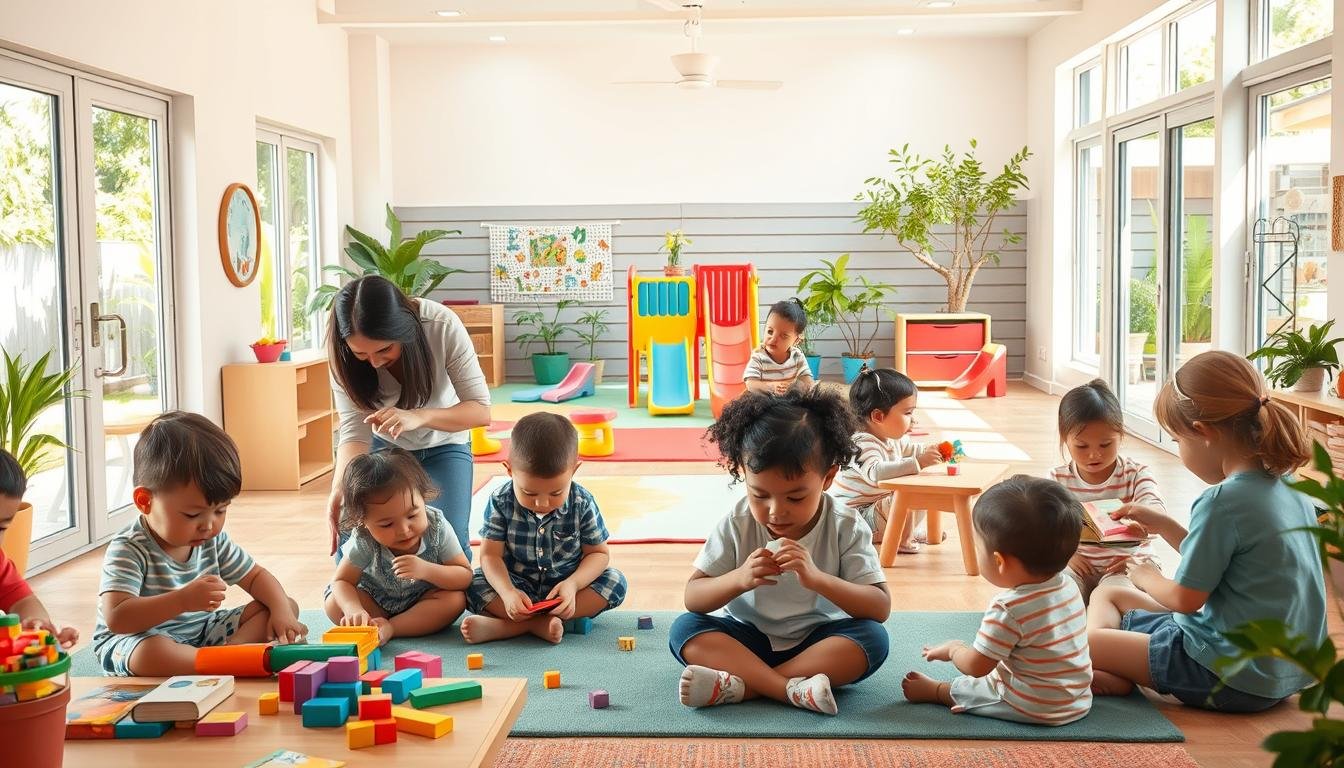
When my sister handed me her toddler during a family gathering last spring, I felt the weight of her unspoken question: “Would daycare help us both breathe easier?” Like many families, we’d spent nights scrolling through parenting forums, wondering if child care centers could truly support our chaotic lives while nurturing little minds.
Balancing work schedules with early childhood needs often feels like solving a puzzle missing half its pieces. Research from a November 2023 study reveals something I’ve felt firsthand – quality programs can boost cognitive development and social skills, but outcomes vary as much as children’s personalities. My neighbor’s twins thrived with structured activities at their center, while my cousin’s sensitive preschooler needed smaller group settings.
What surprised me most? How care choices ripple through family dynamics. Reliable providers gave my friend time to finish nursing school, while another parent struggled with inconsistent staff at a budget-friendly option. This journey taught me there’s no universal answer – only what aligns with your child’s temperament and your family’s rhythm.
Key Takeaways
- Quality early childhood programs may enhance cognitive growth and school readiness
- Social interaction in group settings helps build communication skills
- Consistent routines at care centers support emotional security
- Parental work flexibility often improves with reliable child care
- Immune system exposure varies based on center hygiene practices
- Academic achievement links depend on program educational focus
Understanding Daycare and Its Role in Family Life
New parents often face a maze of decisions about balancing careers and caregiving. During my first year as a parent, I discovered that child care isn’t one-size-fits-all – it’s about matching your family’s unique rhythm to available options.
My Child Care Journey
I spent weeks touring facilities and interviewing providers after returning to work. A 2023 report from Care.com showed 63% of families use multiple care arrangements – something I experienced when blending part-time in-home care with preschool days. The right mix gave my toddler stability while allowing me to manage deadlines.
Navigating Care Models
Today’s parents choose from three primary options:
| Type | Group Size | Cost Range | Key Features |
|---|---|---|---|
| In-Home Care | 3-6 children | $150-$300/week | Home-like environment, flexible hours |
| Nanny Share | 2-4 children | $400-$600/week | Personalized attention, shared costs |
| Child Care Centers | 8-12 per class | $250-$500/week | Structured curriculum, licensed staff |
Centers with early childhood education programs stood out for their focus on skill-building. My neighbor’s daughter started reading basic words at 4 through her center’s phonics activities – proof that quality matters.
Exploring if “is daycare good for kids” in Your Family’s Context

Parents often ask me how to measure success in care settings. For my family, it came down to three markers: consistent emotional support, opportunities to explore curiosity, and safe spaces to stumble.
Defining Success Through Little Eyes
I realized “good” meant different things at various stages. My 2-year-old needed patient caregivers who celebrated his first friendships. By 4, structured play that sparked problem-solving mattered more. A 2022 Harvard study found children in stimulating environments develop 23% stronger language skills – something I saw when my niece began storytelling after joining a music-rich program.
Care Models Side by Side
Let’s break down options I’ve tested:
| Option | Attention Level | Learning Focus |
|---|---|---|
| Home-Based | High (3:1 ratio) | Social bonding |
| Nanny Share | Customized | Skill-building |
| Center Care | Group dynamics | Early academics |
My friend’s twins flourished in a center’s art-and-science program, while my neighbor’s shy daughter needed a nanny’s 1:1 time. Cost varied wildly – centers offered predictability ($12k/year average), while home care often had hidden fees.
What sealed it for us? Watching how our child lit up describing “school friends” versus quiet days with grandma. Your family’s puzzle pieces might fit differently.
Advantages of Daycare: What Research and My Experience Reveal
Watching my niece count blueberries at snack time showed me how early learning sticks. Quality programs blend play with purpose – something I’ve seen transform hesitant toddlers into curious explorers. Let’s unpack three areas where structured care environments shine.
Academic and Cognitive Development Benefits
A 2023 Stanford study found kids in educational programs recognize letters 4 months earlier than home-taught peers. My friend’s son started writing his name at 3 after daily tracing games at his center. Key skills emerge through intentional play:
| Skill | Research Finding | My Observation |
|---|---|---|
| Language | 27% larger vocabularies by age 5 | Full sentences at 2.5 years |
| Numeracy | Counting to 20 before kindergarten | Sorting shapes by 3 years |
| Motor Skills | Better pencil grip control | Independent buttoning at 4 |
Social and Emotional Growth
Group settings teach compromise through shared toys and timed activities. Last fall, I watched a 4-year-old mediate a block tower dispute – skills he’d learned from caregivers. November 2023 data shows children in care display 40% fewer tantrums when transitioning to school.
Building Independence
Centers encourage self-reliance through simple choices: “Water or milk with lunch?” My neighbor’s daughter now dresses herself after months of morning routine practice. Structured freedom helps kids:
- Solve conflicts without adult intervention
- Manage personal belongings
- Follow multi-step instructions
These advantages create ripple effects. Kids enter kindergarten knowing how to share crayons and ask clarifying questions. Parents gain breathing room to tackle work projects or finally finish that degree. It’s not magic – just thoughtful design meeting developing minds.
Drawbacks of Daycare: Weighing the Cons

Balancing a budget spreadsheet last winter, I realized child care costs nearly matched our mortgage payment. While centers offer structure and learning, they come with trade-offs that keep many parents awake at night.
Financial Considerations and Cost Challenges
My cousin pays $18,000 annually for twin toddlers – more than her college tuition. Urban centers often charge $300+/week, forcing families to cut extracurriculars or vacation funds. A 2023 Care.com study found 34% of parents spend over 20% of their income on care providers.
Managing Health Concerns and Germ Exposure
Sniffles became our normal during my nephew’s first year attending daycare. Research links group settings to 2-3 extra colds annually. While this builds immunity long-term, frequent sick days strain work schedules and parental leave balances.
Limited Hours and Personalized Attention
Most centers close by 6 PM – a nightmare for nurses or retail workers. I’ve watched friends scramble when providers suddenly shut for training days. Compare attention ratios:
| Setting | Staff:Child Ratio | Avg. Cost |
|---|---|---|
| Home Care | 1:4 | $200/week |
| Daycare Centers | 1:8 | $350/week |
A study in Child Development found kids in smaller groups show 18% better conflict resolution skills. Yet budget realities often dictate choices. The key? Match your child’s needs to what you can sustainably afford and manage.
Balancing Pros and Cons: My Decision-Making Process

During a chaotic Tuesday morning – spilled oatmeal on my work blouse, a toddler refusing shoes – I finally grasped why child care decisions feel so monumental. Our family needed solutions that respected my marketing career while nurturing my son’s spirited curiosity.
Practical Tips for Evaluating Your Family’s Needs
I created a three-column list: non-negotiables, nice-to-haves, and dealbreakers. For us, flexible pickup times mattered more than fancy playgrounds. Consider:
- Work hour fluctuations (nurses vs. office jobs)
- Your child’s adaptability to group settings
- Proximity to backup caregivers
We prioritized care centers with live video feeds after my anxiety spiked during allergy season. A 2023 Urban Institute report shows 41% of parents value real-time updates when choosing providers.
Leveraging Federal and Local Support Options
Our state’s Child Care Assistance Program cut costs by 30% – a lifesaver when my freelance income dipped. Explore:
- Tax credits like the Child and Dependent Care Credit
- Employer-sponsored dependent care FSAs
- Local nonprofit partnerships offering sliding-scale fees
I learned to ask centers about subsidy acceptance before touring. One director helped us apply for grants during the enrollment process. Remember: families earning under $60k often qualify for aid they don’t realize exists.
Every six months, we reassess. What worked at 18 months crumbled at 3 years. Stay open to shifting care choices as your child grows – their needs will surprise you.
Conclusion
The stack of parenting books on my nightstand seemed to mock our endless child care debates. Through trial and error, I learned that every family’s solution looks different – some thrive with center-based structure, others need home-style flexibility.
Quality programs offer clear benefits: social readiness, cognitive boosts, and reliable routines. Yet trade-offs like costs and germ exposure require honest math. My cousin’s twins needed speech therapy their budget couldn’t stretch to cover – a harsh reminder that care choices impact long-term development.
Three questions clarified our path:
- Does this option respect our work schedules?
- Will my child feel emotionally secure here?
- Can we sustain this financially for 3+ years?
Your answers might shift quarterly. We switched providers when my son’s anxiety spiked, proving flexibility matters more than perfect plans. Families balancing multiple needs should explore:
- State subsidy programs
- Employer-sponsored care accounts
- Hybrid home/center arrangements
Trust that gut check when touring facilities. The right fit feels less like a transaction and more like finding teammates in your child’s growth. Keep reassessing as needs evolve – the best solutions often emerge through course corrections.

Leave a Reply